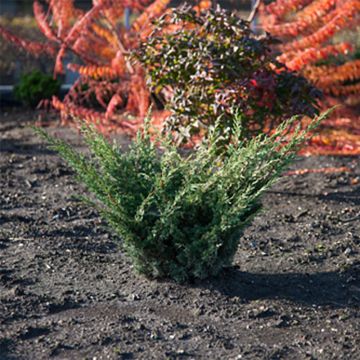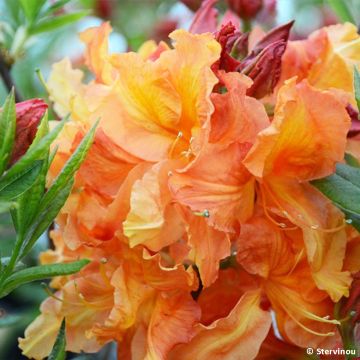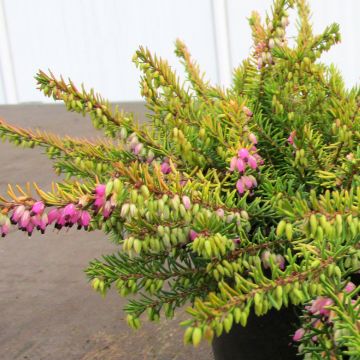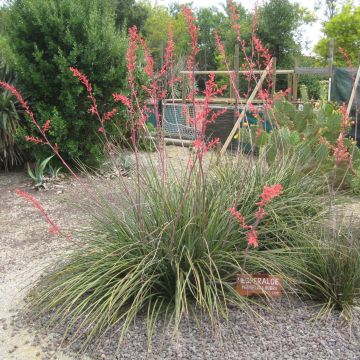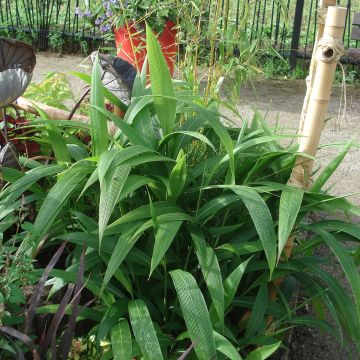

Leucospermum Ayoba Red - Pelote d'épingles Rouge
Leucospermum Ayoba Red - Red Spike Pincushion
Leucospermum cordifolium x patersonii Ayoba Red
Pincushion
This item cannot be shipped to the selected country
Delivery charge from €5.90
More information
Schedule delivery date,
and select date in basket
This plant carries a 24 months recovery warranty
More information
We guarantee the quality of our plants for a full growing cycle, and will replace at our expense any plant that fails to recover under normal climatic and planting conditions.
From €5.90 for pickup delivery and €6.90 for home delivery
Express home delivery from €8.90.
Does this plant fit my garden?
Set up your Plantfit profile →
Description
The Leucospermum 'Ayoba Red', commonly known as the Pincushion, is a bush of South African origin related to proteas. This remarkably compact and floriferous hybrid variety reaches a height of about 1m (3ft) at maturity, with a similar spread. Its long spring flowering consists of original inflorescences of deep red colour. It is a coastal bush, well adapted to sea spray and sandy and dry soils in summer. It can be a magnificent specimen with an intensely exotic appearance. Continental gardeners will appreciate its small size for container gardening on the terrace to be stored away in winter.
The Leucospermum 'Ayoba Red' belongs to the protea family, like Grevillea and Protea. Leucospermum is native to South Africa and is found in coastal heathlands and sclerophyllous (dry) forests. It naturally develops in sandy, acidic, leached, and well-drained soils but adapts very well to rocky and clayey (non-calcareous) or loamy soils. Its appearance and morphology vary greatly depending on its habitat, and there are several subspecies and ecotypes. The hybrid cultivar 'Ayoba Red' was selected by the South African nursery "Future Fynbos" from a cross-breeding of L. cordifolium and L. patersonii.
With a bushy and branched habit, this small-sized bush grows relatively slowly and generally forms a rounded crown. It will reach an average height of 1m (3ft) with a 1m (3ft) spread, depending on the growing conditions. Its branches carried on one or more trunks with corky bark, are covered with tough, medium green, glabrous, and toothed leaves at their tips. They are densely spiralled around the stem. Flowering can occur from March to May, depending on the climate. It is not uncommon for the bush to sporadically flower outside these periods, depending on the region. The pincushion-like inflorescences are very intense and vibrant red; they are highly appreciated by pollinating insects. Most Leucospermum species are pyrophytic, meaning they require the heat of the fire to release their fruits and seeds.
The Leucospermum 'Ayoba Red' is a quite sensational plant that leaves no one indifferent. Despite its lack of hardiness (down to -5°C (23°F) for short periods), this bush is fairly easy to grow in coastal gardens, in sandy and poor, regularly dry soil. Particularly suited to Mediterranean climates, it thrives in harsh, dry, and arid soils. This compact variety will be splendidly planted in a dry rock garden, in a pot on a terrace, but always in an open position, in full sun. It is also appreciated for its long vase life, which allows it to compose fabulous bouquets with vibrant colours.
An original root system adapted to poor and dry soils:
Plants that grow in nutrient-poor soils often form a symbiosis with soil fungi that enhance water and nutrient absorption. However, the Proteaceae family has chosen a different strategy: they develop many specialised lateral roots along their main roots. These roots are called proteoid roots and are induced by rain, developing under the layer of dead leaves that cover the base of the plant. Rain promotes leaf decomposition, resulting in the release of nutrients. These ephemeral roots usually dry up at the end of the growing season. They have twice the water and nutrient absorption activity than "normal" roots.
Report an error about the product description
Leucospermum Ayoba Red - Red Spike Pincushion in pictures




Plant habit
Flowering
Foliage
Botanical data
Leucospermum
cordifolium x patersonii
Ayoba Red
Proteaceae
Pincushion
South Africa
Other Shrubs A to Z
Planting and care
In the ground, in our regions spared from severe frost, plant the Leucospermum, preferably in spring, in a sunny location. This plant is quite tolerant of the soil but does not appreciate limestone and permanently wet soils. If it prefers sandy soil with an acidic or neutral tendency (pH<7), it adapts well to loamy or clayey soils that are well-drained and light. Water abundantly but spaced out (20 liters of water every 15 days) to help with establishment and promote deep rooting, especially during the first two summers if the weather remains dry. Stake your young plant for as long as necessary for it to root. Once well-established, after 2 or 3 years of cultivation, the Leucospermum grown in the ground does not require watering in summer, except in case of exceptional drought. It tolerates sea spray and wind perfectly. Phytophthora is a fungal disease that attacks the roots and collar of certain woody plants in wet and warm soils.
Proteaceae are sensitive to excess phosphates and nitrates, so it is necessary to avoid giving too much fertiliser or even not giving any at all. A small dose of bonemeal at the base of the plant in spring is generally sufficient. While adult plants tolerate occasional frost down to -5°C (23°F) in dry soil, regrowing from the stump, young Leucospermum, on the other hand, should be protected from frost during their first years, either in a frost-free area in cool climates or under a winter cover in regions with mild winters.
Pot cultivation:
Indoors, it is essential to ensure good ventilation and avoid excessively dry and hot atmospheres. A slightly heated conservatory or a frost-free greenhouse would be perfect. A potted plant requires regular but spaced-out watering. Do not let the pot sit in a saucer full of water; use a pot with drainage holes in the bottom and create a layer of clay balls or gravel to promote drainage. In winter, watering should be reduced by half compared to normal while ensuring the root ball does not completely dry out.
Take your Leucospermum outside after the last frost, and apply a layer of low-phosphorus potting soil or well-rotted humus mixed with sand on the soil's surface.
Planting period
Intended location
Care
This item has not been reviewed yet - be the first to leave a review about it.
Evergreen shrubs
Haven't found what you were looking for?
Hardiness is the lowest winter temperature a plant can endure without suffering serious damage or even dying. However, hardiness is affected by location (a sheltered area, such as a patio), protection (winter cover) and soil type (hardiness is improved by well-drained soil).

Photo Sharing Terms & Conditions
In order to encourage gardeners to interact and share their experiences, Promesse de fleurs offers various media enabling content to be uploaded onto its Site - in particular via the ‘Photo sharing’ module.
The User agrees to refrain from:
- Posting any content that is illegal, prejudicial, insulting, racist, inciteful to hatred, revisionist, contrary to public decency, that infringes on privacy or on the privacy rights of third parties, in particular the publicity rights of persons and goods, intellectual property rights, or the right to privacy.
- Submitting content on behalf of a third party;
- Impersonate the identity of a third party and/or publish any personal information about a third party;
In general, the User undertakes to refrain from any unethical behaviour.
All Content (in particular text, comments, files, images, photos, videos, creative works, etc.), which may be subject to property or intellectual property rights, image or other private rights, shall remain the property of the User, subject to the limited rights granted by the terms of the licence granted by Promesse de fleurs as stated below. Users are at liberty to publish or not to publish such Content on the Site, notably via the ‘Photo Sharing’ facility, and accept that this Content shall be made public and freely accessible, notably on the Internet.
Users further acknowledge, undertake to have ,and guarantee that they hold all necessary rights and permissions to publish such material on the Site, in particular with regard to the legislation in force pertaining to any privacy, property, intellectual property, image, or contractual rights, or rights of any other nature. By publishing such Content on the Site, Users acknowledge accepting full liability as publishers of the Content within the meaning of the law, and grant Promesse de fleurs, free of charge, an inclusive, worldwide licence for the said Content for the entire duration of its publication, including all reproduction, representation, up/downloading, displaying, performing, transmission, and storage rights.
Users also grant permission for their name to be linked to the Content and accept that this link may not always be made available.
By engaging in posting material, Users consent to their Content becoming automatically accessible on the Internet, in particular on other sites and/or blogs and/or web pages of the Promesse de fleurs site, including in particular social pages and the Promesse de fleurs catalogue.
Users may secure the removal of entrusted content free of charge by issuing a simple request via our contact form.
The flowering period indicated on our website applies to countries and regions located in USDA zone 8 (France, the United Kingdom, Ireland, the Netherlands, etc.)
It will vary according to where you live:
- In zones 9 to 10 (Italy, Spain, Greece, etc.), flowering will occur about 2 to 4 weeks earlier.
- In zones 6 to 7 (Germany, Poland, Slovenia, and lower mountainous regions), flowering will be delayed by 2 to 3 weeks.
- In zone 5 (Central Europe, Scandinavia), blooming will be delayed by 3 to 5 weeks.
In temperate climates, pruning of spring-flowering shrubs (forsythia, spireas, etc.) should be done just after flowering.
Pruning of summer-flowering shrubs (Indian Lilac, Perovskia, etc.) can be done in winter or spring.
In cold regions as well as with frost-sensitive plants, avoid pruning too early when severe frosts may still occur.
The planting period indicated on our website applies to countries and regions located in USDA zone 8 (France, United Kingdom, Ireland, Netherlands).
It will vary according to where you live:
- In Mediterranean zones (Marseille, Madrid, Milan, etc.), autumn and winter are the best planting periods.
- In continental zones (Strasbourg, Munich, Vienna, etc.), delay planting by 2 to 3 weeks in spring and bring it forward by 2 to 4 weeks in autumn.
- In mountainous regions (the Alps, Pyrenees, Carpathians, etc.), it is best to plant in late spring (May-June) or late summer (August-September).
The harvesting period indicated on our website applies to countries and regions in USDA zone 8 (France, England, Ireland, the Netherlands).
In colder areas (Scandinavia, Poland, Austria...) fruit and vegetable harvests are likely to be delayed by 3-4 weeks.
In warmer areas (Italy, Spain, Greece, etc.), harvesting will probably take place earlier, depending on weather conditions.
The sowing periods indicated on our website apply to countries and regions within USDA Zone 8 (France, UK, Ireland, Netherlands).
In colder areas (Scandinavia, Poland, Austria...), delay any outdoor sowing by 3-4 weeks, or sow under glass.
In warmer climes (Italy, Spain, Greece, etc.), bring outdoor sowing forward by a few weeks.

































